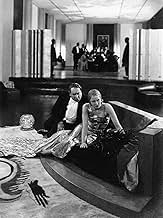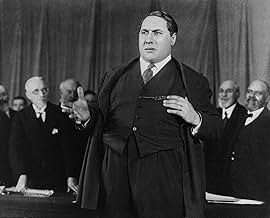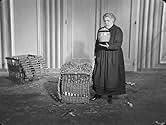The business tycoon Nicolas Saccard is nearly ruined by his rival Gunderman, when he tries to raise capital for his company. To push up the price of his stock, Saccard plans a publicity stun... Read allThe business tycoon Nicolas Saccard is nearly ruined by his rival Gunderman, when he tries to raise capital for his company. To push up the price of his stock, Saccard plans a publicity stunt involving the aviator Jacques Hamelin flying across the Atlantic to Guyana and drilling ... Read allThe business tycoon Nicolas Saccard is nearly ruined by his rival Gunderman, when he tries to raise capital for his company. To push up the price of his stock, Saccard plans a publicity stunt involving the aviator Jacques Hamelin flying across the Atlantic to Guyana and drilling for oil there, much to the dismay of Hamelin's wife Line. While Hamelin is away, Saccard t... Read all
- Line Hamelin
- (as Mary Glory)
- Massias
- (as Al. Mihalesco)
- Daigremont
- (uncredited)
- Director
- Writers
- All cast & crew
- Production, box office & more at IMDbPro
Storyline
Did you know
- TriviaThere are 1,952 shots in the film, with an average shot length of just six and a half seconds.
- Alternate versionsThe film was shown to the French press in December 1928 in a cut lasting about 3 hours and 20 minutes, however by the time the film had its first public screening in January 1929, producer Jean Sapene had ordered the length to be cut by half, unbeknownst to director Marcel L'Herbier and much to his and fellow filmmaker Marcel Carné's dismay. Much later, the film was restored to a running time of 2 hours and 25 minutes.
- ConnectionsFeatured in The Twentieth Century: The Movies Learn to Talk (1959)
Undoubtedly influenced by Abel Gance's experiments with camera mobility, L'Herbier turned this very free, modern-day version of Zola's celebrated novel into a series of pretexts for outbursts of striking cinematic excess, creating a strikingly modern work marked by its opulent, over-sized sets and a complex, multi-camera shooting style. The result is a film resolutely split between narrative and spectacle, between straightforward storytelling scenes typically dominated by shot-reverse shot cutting and chaotic, exciting impressionist sequences, as when, at the Paris stock market (shot on location) a camera hanging from a pulley apparatus high above the trading floor sweeps down on the traders. The effect, presumable, means to evoke the irrational frenzy of capitalist from a decidedly right-wing perspective.
If Gance's Napoleon and Carl Th. Dreyer's La Passion de Jeanne d'Arc constitute the apex of big-budget historical reconstruction films in the French silent cinema, then L'Argent certainly can be taken as the culmination of the modern studio spectacular. With a five-million franc budget, L'Herbier was given privileged access to the Paris Bourse for three days of shooting (with 1,500 actors and over a dozen cameramen) and was permitted to electrify the Place de l'Opera in order to shoot a night scene of the huge crowd awaiting news of Hamelin's solo transatlantic flight. At the newly opened Studios Francoeur, Lazare Meerson and Andre Barsacq constructed immense set decors, including an enormous bank interior, several large offices and vast apartments, a dance stage for Saccard's celebration party, and an unusual circular room next to Gundermann's office whose entire wall length was covered with a giant world map.
Many of these studio spaces have smooth, polished surfaces and are stylized to the point of exhibiting little more than walls, ceilings, and floors. This stark simplicity, especially in such monumental designs, undermines any appeal to verisimilitude and tends to dissolve the boundaries differentiating one space from another. The indeterminacy of these decors, although exemplary of the modern studio spectacular, thus specifically functions to further abstract the film's capitalist intrigue. Together withe crowds of extras that often traverse the frame and chief cameraman Jules Kruger's selection of slightly wide-angle lenses and high- and low camera positions, especially for the frequent long shots or extreme long shots they produce a consistently deep-space mise-en-scene and larger than life capitalists. Furthermore, the highly stylized or generalized milieu of the film actually serves to foreground the nationalistic and class-based terms of the intrigue, articulated through the casting, and allows them to read all that more clearly.
The Modernizing strategy that shapes L'Argent's set decors and deep-space mise-en-scene was also governed, finally, by a loosely systematic discursive which many French filmmakers shared in the late 1920s. Generally, the French tended to privilege the specifically 'cinematic' elements of framing and editing - close ups (especially of objects), unusually high and low camera position, extensive camera movement, superimposition's and dissolves, various forms of rhythmic montage, associative editing. But L'Herbier's L'Argent offers another, perhaps even more interesting model for the way its reflexive style ultimately helps to articulate the film's critique of capital.
At least two particular features of this film practice loom large in L'Argent. The first feature as an absolutely unprecedented mobile camera strategy, whose high visibility and extreme dynamism render its effect peculiarly ambiguous. The range and extent of the film's camera movement is unmatched except perhaps by that in Gance's Napoleon (for which Kruger was also chief cameraman). Largely because of such unusual camera movements, in L'Argents space oscillates uncannily between the fixed and the fluid. A second feature of the film's discursive practice is its rather unconventional editing patterns, which sometimes work in tandem with camera movement. There is the uniquely persistent pattern of cutting a stable shot as a sudden camera movement becomes perceptible, which creates a slightly jarring effect in the film's rhythm that ruptures its sense of spatio-temporal continuity and foregrounds the very construction of filmic space-time.
The reflexivity of this discursive practice marks L'Argent as a Modernist text, of course, at least to the extent that the materials of the film medium and their deployment as a disruptice system become an ancillary subject of the film. L'Argents framing and editing techniques, in conjunction with set design and acting style or casting, more closely resemble those of Jean Renoir's Nana or Dreyer's La Passion de Jeanne d'Arc, both of which serve to subvert the conventions of another genre, the historical reconstruction. Yet reflexivity here bears a subversive significance that exceeds the genre of the modern studio spectacular precisely because of L'Argent is a story of capital.
L'Argent's achievement, in the end, rests on the correlation it makes between discourse, narrative, and the subject of capital. Capital is both everywhere and nowhere, echoing Marx; it motivates nearly every character in the film and is talked about incessantly, but it is never seen or - as the dung on which life thrives - even scented.
Nevertheless, L'Argent is a beacon of modernity, an over-sized hymn to music of light, where everything is rhythm, movement, and a fantastic spiral of financial manipulations. Even today, the subject is astonishingly relevant.
Details
- Release date
- Country of origin
- Languages
- Also known as
- Money
- Filming locations
- La Bourse, Paris 2, Paris, France(interior: shots from the ceiling covering the crowd movement of buying and selling orders)
- Production companies
- See more company credits at IMDbPro
Box office
- Budget
- FRF 5,000,000 (estimated)
- Runtime3 hours 15 minutes
- Color
- Sound mix
- Aspect ratio
- 1.33 : 1
Contribute to this page


































